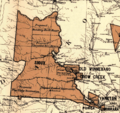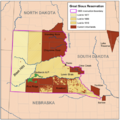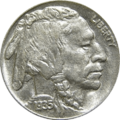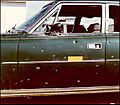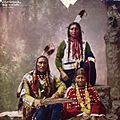Pine Ridge Indian Reservation facts for kids
Quick facts for kids
Pine Ridge Indian Reservation
Wazí Aháŋhaŋ Oyáŋke
Pine Ridge Agency
|
||
|---|---|---|
|
||
| Nickname(s):
Pine Ridge Rez
|
||
| Anthem: ("Wapaha kiŋ kekah'boyaŋhan" and "Lakota Flag Song" used for some occasions) |
||
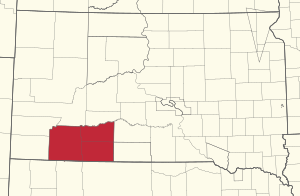
Location in South Dakota
|
||
| Tribe | Oglala Sioux | |
| Country | United States | |
| States | South Dakota (99%) Nebraska (1%) |
|
| Counties | Bennett (all) Jackson (part) Oglala Lakota (all) Sheridan (part) |
|
| Headquarters | Pine Ridge | |
| Area | ||
| • Total | 8,984.3 km2 (3,468.86 sq mi) | |
| Population
(2017)
|
||
| • Total | 19,779 | |
| • Density | 2.20151/km2 (5.70187/sq mi) | |
| Time zone | UTC-7 (MST) | |
| • Summer (DST) | UTC-6 (MDT) | |
| Website | oglalalakotanation.info | |
The Pine Ridge Indian Reservation (Lakota: Wazí Aháŋhaŋ Oyáŋke), also known as Pine Ridge Agency, is a special area of land set aside for the Oglala Lakota people. It is located in the state of South Dakota, near the border with Nebraska.
This reservation was created in 1889. It was once part of the much larger Great Sioux Reservation. Today, Pine Ridge is one of the biggest reservations in the United States, covering about 3,469 square miles (8,984 km²).
The reservation includes all of Oglala Lakota County and Bennett County. It also covers parts of Jackson County and Sheridan County. In 2017, about 19,779 people lived on the reservation.
Pine Ridge is a very important place in the history of the Sioux people and the United States government. It was the site of the last Ghost Dances. These dances were part of a spiritual movement. The U.S. government tried to stop them. This led to the sad event known as the Wounded Knee Massacre on December 29, 1890. Many Lakota people, including women and children, lost their lives. This event marked the end of major conflicts between U.S. forces and Native Americans.
Over the years, the reservation has seen many changes. In 1971, the Oglala Sioux Tribe started Oglala Lakota College. This college offers 4-year degrees. In 1973, a protest called the Wounded Knee Incident happened. Members of the Oglala Lakota and the American Indian Movement protested for 71 days. This event brought attention to Native American rights. It also helped bring back some cultural traditions on the reservation.
The reservation is located near the southern part of the Badlands. This area is a special natural zone called a mixed grass prairie. It has many different plants and animals. This includes the rare black-footed ferret. The area is also important for finding fossils. Scientists have found many fossils of ancient mammals here.
Contents
Exploring Nature: Plants and Animals of Pine Ridge
The Pine Ridge Reservation is a vibrant home for many types of plants and animals. It sits in a special area called the mixed grass prairie. This means it has both short and tall grasses.
Diverse Plant Life: Flora of the Prairie
The mixed grass prairie is a unique place where different types of grasses grow together. Scientists have found over 400 kinds of plants in this area. Each plant is specially made to live in the extreme weather here. The climate can be very hot, cold, dry, windy, and stormy. It can have blizzards, floods, droughts, and fires.
This area is special because it mixes plants from the short-grass prairie to the west and the tall-grass prairie to the east. Because of this mix, you can find more kinds of plants here than in other prairie areas.
Amazing Animal Life: Fauna of the Prairie
The mixed grass prairie is also home to many animals. In nearby Badlands National Park, scientists have counted 37 types of mammals. They have also found 9 kinds of reptiles, 6 kinds of amphibians, 206 kinds of birds, and 69 kinds of butterflies.
Some of the special animals found here are the rare swift fox and the endangered black-footed ferret. Both of these animals hunt the black-tailed prairie dog for food. You can also see large herds of bison (tȟatȟáŋka) grazing on the prairie. The Oglala people on the reservation help care for a bison herd.
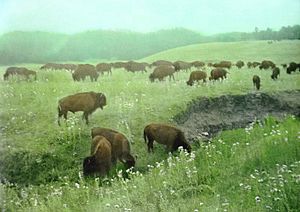
Getting Around: Transportation on the Reservation
The Pine Ridge Reservation has several ways to travel, including roads and an airport.
Roads for Travel
Several important roads pass through or near the reservation:
 I-90: This major interstate highway runs east to west just north of the reservation.
I-90: This major interstate highway runs east to west just north of the reservation. US 18: This U.S. highway goes through the reservation from east to west.
US 18: This U.S. highway goes through the reservation from east to west. SD 44: Also known as "Rimrock Highway," this scenic road passes through the Jackson County part of the reservation.
SD 44: Also known as "Rimrock Highway," this scenic road passes through the Jackson County part of the reservation. SD 73: This state route runs north to south through the Jackson County part of the reservation.
SD 73: This state route runs north to south through the Jackson County part of the reservation. SD 407: This shorter state highway in Oglala Lakota County connects to Nebraska Highway 87.
SD 407: This shorter state highway in Oglala Lakota County connects to Nebraska Highway 87.
Airports for Flights
The Pine Ridge Airport is owned by the Oglala Sioux Tribe. It is mainly used for government flights. The closest airport for regular passenger flights is Chadron Municipal Airport in Chadron, Nebraska, about 30 miles (48 km) south. A larger airport, Rapid City Regional Airport, is about 80 miles (129 km) northeast in Rapid City, South Dakota.
Public Bus Service
Since 2009, the Oglala Sioux Tribe has offered a public bus service. This service helps people travel across the entire reservation.
Communities on the Reservation

The Pine Ridge Indian Reservation is home to several communities:
- Nebraska:
- South Dakota:
Inspiring People: Leaders and Residents of Pine Ridge
Many notable people have come from or lived on the Pine Ridge Indian Reservation. They have made important contributions in various fields.
- Albert Afraid of Hawk (1879-1900, Oglala): He was part of Buffalo Bill's Wild West Show. His remains were returned to his homeland in South Dakota in 2012, 112 years after his death.
- American Horse (1840 – 1908, Oglala Lakota): A respected chief during the Sioux Wars of the 1870s.
- Amos Bad Heart Bull: A talented ledger artist and tribal historian.
- Alice Blue Legs (1925-2003): A master quillworker who helped keep this traditional art alive.
- Tokala Clifford: An actor.
- Chief Crazy Horse: A famous war chief of the Oglala Lakota people around 1870.
- SuAnne Big Crow: She led the Pine Ridge High School basketball team to a state championship in 1989.
- Pat Cuny (Oglala): A soldier in WWII who fought in the Battle of the Bulge. He also helped free people from a concentration camp.
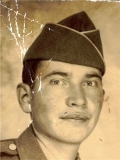
- Ed McGaa (Eagle Man): An author, lawyer, and U.S. Marine Corps pilot. He flew many combat missions in Vietnam and received several awards for his bravery.
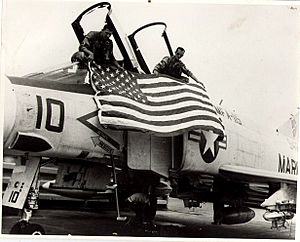
- Cecilia Fire Thunder: The first woman elected as president of the Oglala Sioux Tribe in 2004. She works to support women and revive the Lakota language.
- Tim Giago: He started the first independent Native American newspaper, Lakota Times. He is also a writer for the Huffington Post.
- Brady Jandreau: A former rodeo rider and the star of the 2018 film The Rider.
- Kicking Bear (Oglala): A chief of the Miniconjou Lakota Sioux tribe. He fought in battles and was important in the Ghost Dance religious movement of 1890.
- Eddie Little Sky: An actor.
- Little Wound (1835–1899, Oglala): A chief who led the Kuinyan branch of the Kiyuksa band.
- Chief Long Wolf (1833–1892): A warrior who fought in the Battle of the Little Bighorn. He traveled with Buffalo Bill's Wild West Show in Europe. His remains were returned to his homeland in 1997.
- Old Chief Smoke (1774–1864): An early Oglala chief.
- Black Elk (1863–1950): A respected Oglala holy man and a cousin to Crazy Horse.
- Chief Red Cloud (1822–1909, Oglala): A chief, warrior, and statesman. He worked to establish a school for Native American children at Pine Ridge.
- Philip N. Hogen: Served as the United States Attorney for the District of South Dakota from 1981 to 1991.
- Ola Mildred Rexroat: The only Native American pilot in the Women Airforce Service Pilots (WASP) during WWII.
- Sean Sherman: A food educator, chef, and author of The Sioux Chef's Indigenous Kitchen.
- Chief Spotted Elk: Also known as Big Foot. His band of Miniconjou Sioux were tragically killed at Wounded Knee in 1891.
- Touch the Clouds: An Oglala chief.
- JoAnn Tall: An environmental activist from Pine Ridge, recognized for her work against uranium mining on the reservation.
- Theresa Two Bulls: The first American Indian woman elected to the South Dakota legislature. She also served as president of the Oglala Sioux Tribe.
- Richard Wilson (1934 – 1990): Tribal chairman from 1972 to 1976 during the Wounded Knee Incident.
- John Yellow Bird Steele: Elected president of the Oglala Sioux Tribe six times.
- Young Man Afraid Of His Horses (1830–1900): His name means "They fear his horse," showing how respected he was as a warrior.
- Charles Trimble (Oglala Lakota Nation): An activist and former Executive Director of the National Congress of American Indians.
- William Mervin "Billy" Mills: Also known as Makata Taka Hela. He is the only American man to win an Olympic gold medal in the 10,000-meter run.
Images for kids
-
Great Sioux Reservation, 1888; established by Treaty of Fort Laramie (1868)
-
Map showing the Great Sioux Reservation, subsequent loss of land to the federal government, and current holdings of the various Sioux reservations
-
A 1911 ad offering former reservation land for sale. Most of the "allotted Indian land" sold the previous year (1910) was Sioux land.
-
Tavern in Whiteclay, Nebraska (1940)
-
A model for the Indian Head Nickel, or Buffalo Nickel, had his home taken when the Badlands Bombing Range was seized.
-
Chief Little Wound with his wife and son (1899 Heyn photo)
-
The White River and multiple tributaries cut across the reservation




